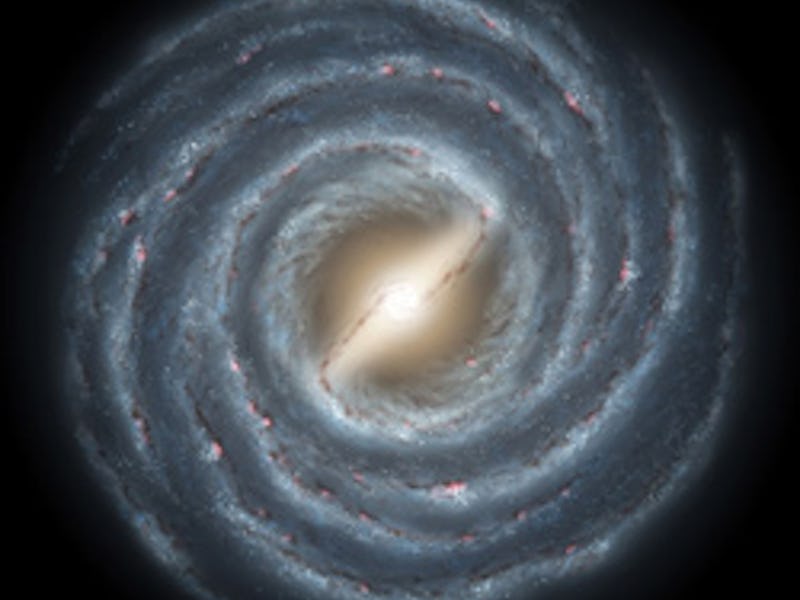The Milky Way's twin contradicts a popular theory about our galaxy
A new study contradicts the galaxy's origin story and makes us shockingly ordinary.

While observing a distant galaxy located 320 million light years away, a team of astronomers from Australia stumbled upon something oddly familiar.
The galaxy, dubbed UGC 10738, had a thick disc containing ancient stars formed billions of years ago and a thin disc of relatively younger stars. The two star-filled discs were strikingly similar to those located in the Milky Way galaxy.
This revelation presented the astronomers with a rare opportunity to compare our own galaxy with its very own galactic twin, a galaxy that may have evolved in a similar fashion to the Milky Way. By doing so, they found that the Milky Way may have evolved gradually over time rather than having formed as a result of a massive collision between galaxies.
The findings suggest that contrary to popular belief, the Milky Way may be a rather common galaxy.
The study was published Monday in The Astrophysical Journal Letters.
WHAT’S NEW — Using the European Southern Observatory’s Very Large Telescope in Chile, the team behind the new study was able to observe galaxy UGC 10738 in great detail.
Scientists were able to peer into the construction of the galaxy so intimately because UGC 10738 is angled edge-on, making it easy to spot the stars in each of its discs.
Could this be the Milky Way’s long lost galactic twin?
“It’s a bit like telling apart short people from tall people,” Nicholas Scott, a postdoctoral research fellow at the University of Sydney and lead author of the new study, says in a statement. “If you try to do it from overhead it’s impossible, but if you look from the side, it’s relatively easy.”
But instead of telling apart people’s height, the researchers observed the age of the stars that had formed in the galaxy.
- Their observations revealed that galaxy UGC 10738 has a thick disc consisting mostly of ancient stars, which have a low ratio of iron to hydrogen and helium, while its thin disc stars are younger and contain more metal — a sign that they formed from material left over by previous generations of stars.
- Our Sun is a thin disc star, forming around 4.5 billion years ago.
- These discs have been observed in galaxies before, but it was nearly impossible to tell whether they hosted the same kind of star distribution between the two discs.
- By confirming that this galaxy has a similar distribution of young and old stars between its thin and thick discs, the astronomers concluded that it had a similar origin story to that of the Milky Way.
“From these results, we think galaxies with the Milky Way’s particular structures and properties could be described as the ‘normal’ ones,” Scott says.
HERE’S THE BACKGROUND — Nearly 14 billion years ago, enormous clouds of gas and dust collapsed under the weight of their own gravity to form the Milky Way.
These clouds then formed two main structures: a spherical halo, and a dense, bright disk.
Many astronomers believe that a massive collision formed the Milky Way, shaping it into the spiral galaxy it is today. A popular theory suggests that around 11 billion years ago, a small galaxy called Gaia-Enceladus slammed into the primordial Milky Way.
The Milky Way is headed for a collision with its neighboring galaxy, Andromeda, within the next several billion years.
But the new study suggests that instead of a massive collision, the Milky Way came to be by way of natural progression.
“Our observations indicate that the Milky Way’s thin and thick discs didn’t come about because of a gigantic mash-up, but a sort-of ‘default’ path of galaxy formation and evolution,” Scott says. “From these results, we think galaxies with the Milky Way’s particular structures and properties could be described as the ‘normal’ ones.”
Based on previous evidence, scientists suggested that the Milky Way was unique in that it formed as a result of mergers with other, smaller galaxies and therefore its structure was not observable with other spiral galaxies.
But the recent observations of galaxy UGC 10738 suggest otherwise.
WHY IT MATTERS — Although it’s hard to draw a definitive conclusion from the observations of another galaxy that is seemingly similar to the Milky Way, the new study helps scientists understand how galaxies formed and evolved over time.
The new findings also don’t necessarily contradict the theory that the Milky Way collided with other smaller galaxies over time, leading to its structure today.
This is perhaps the closest comparison scientists have observed to our home galaxy and may suggest that the Milky Way is somewhat typical.
“We know a lot about how the Milky Way formed, but there was always the worry that the Milky Way is not a typical spiral galaxy,” Ken Freeman, professor at the Australian National University, and co-author of the study, says in a statement. “Now we can see that the Milky Way’s formation is fairly typical of how other disk galaxies were assembled.”
But more observations of other fairly similar galaxies are needed before re-writing the origin story of the Milky Way.
Abstract: The Milky Way disk consists of two prominent components — a thick, alpha-rich, low-metallicity component and a thin, metal-rich, low-alpha component. External galaxies have been shown to contain thin and thick disk components, but whether distinct components in the [α/Fe]–[Z/H] plane exist in other Milky Way-like galaxies is not yet known. We present VLT-MUSE observations of UGC 10738, a nearby, edge-on Milky Way-like galaxy. We demonstrate through stellar population synthesis model fitting that UGC 10738 contains alpha-rich and alpha-poor stellar populations with similar spatial distributions to the same components in the Milky Way. We discuss how the finding that external galaxies also contain chemically distinct disk components may act as a significant constraint on the formation of the Milky Way’s own thin and thick disk.
This article was originally published on